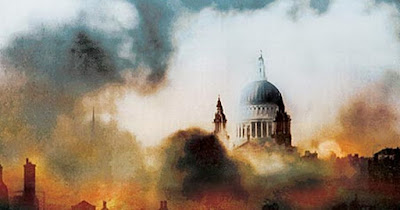St PAUL'S CATHEDRAL LONDON
- A GREAT SURVIVOR -
G'day folks,
The foundation stone for St. Paul’s, one of the most famous cathedrals in the world, was laid on June 21 1675 as work began to replace its enormous Gothic predecessor, which had been destroyed in the Great Fire of London.
The still celebrated architectural masterpiece designed by Christopher Wren, who was then only 34 years of age, is the fifth church to have stood on the spot since the year 604.
St Paul’s is the burial place of famous Britons such as Horatio Nelson
and the Duke of Wellington, who defeated Napoleon at the Battle of
Waterloo. It has also been at the centre of royal celebrations such as
the diamond jubilee of Queen Victoria in 1897, the silver jubilee of King George V in 1935, and the diamond jubilee in 2012 of the present Queen, Elizabeth II.
The wedding of Prince Charles and Lady Diana Spencer
at St. Paul's in 1981 was watched by 750 million people around the
world. And it was here that state funerals were held for Sir Winston Churchill in 1965 and Margaret Thatcher in 2013.
The most perilous days for the cathedral came in what became known as
The Blitz during the Second World War – the eight-month intense bombing
campaign in 1940 and 1941 launched by Nazi Germany against London and
other UK cities.
On the night of December 29, 1940,
100,000 bombs were dropped on London causing more than 1,500 fires and
turning the City of London’s Square Mile into a furnace. It was later
reported that in the 1,000-degree heat, stone walls cracked and
crumbled, iron girders twisted, glass melted, and road surfaces burst
spontaneously into flames.
The lit-up night sky could be seen 100 hundred miles away on the French
coast, and an American war reporter cabled his office: “The second Great
Fire of London has begun.”
At the heart of it all was St Paul’s, but aware of its historical, psychological and religious significance, Prime Minister Winston Churchill
issued orders that the cathedral must be saved at all costs. He knew
how it would lift the spirits of a war-weary public if they could see it
had survived the onslaught. Volunteer firefighter Harold Newell needed
no telling. “If St Paul’s goes down, then we all go down,” he said.
This was the 114th night of the Blitz on London, and standing on a Fleet
Street roof, photographer Herbert Mason captured the astonishing sight
of the nearby cathedral dome, surrounded by devastation but still
intact. His now-famous photograph is reproduced above.
“Through the smoke you could see the fires increasing and, as the
evening wore on, an artificial wind sprang through the heat,” he wrote.
“It parted the clouds, the buildings in the foreground collapsed. And
there, revealed in all its majesty, was St Paul’s.”
The fires were to burn for days but an army of firefighters, men and
women, hampered by ruptured water mains, fought to keep 1,700 pumps
working flat-out.
In his book, Firefighters And The Blitz, Francis Beckett writes: “While
the men manned the pumps, the women were driving petrol carriers,
canteen vans and staff cars into the thickest parts of the blaze,
ensuring the pumps had fuel to keep going.
“Driving vans laden with cans of petrol through the flames that night was about as dangerous a job as you could do.”
The brave firefighters saved many of London’s historic buildings from
total destruction, including, of course, St Paul’s Cathedral.
Sir Christopher Wren died in 1723
at the age of 90 and was the first person to be buried in St Paul’s.
His epitaph, set in a great circle in the floor directly under the dome,
states in Latin: Lector, si monumentum requiris, circumspice –
“Reader, if you seek his monument, look around.”


No comments:
Post a Comment